Sketch Fridays #13 – Building on Napkins
When discussing influence and inspiration, artists tend to look outward at things and people and objects, using those as maps of talent showing how to get to where we currently stand. It makes sense because artists are, by the very nature of how drawing works, construction workers on a less physically demanding scale. A drawing is built not grown or blossomed. It takes a lot of work to make a world, with paper or canvas or screen becoming the window through which the viewer observes and reflects, so to speak.
I do the same thing, looking outward at my inspirations. I have written about many of them already.
However, I am in the position––perhaps the lucky position, perhaps damning––of being the third generation artist in my family. We all used the skill to varying degrees, but it is safe to say that my grandfather, my father, and I all gravitated toward art and practiced it even if the reasons and goals differed.
My grandfather, A.C.W. Bethel––but who went by “Charlie”––worked as a professional commercial artist, making adverts for a relative’s pharmaceutical company while pulling down some commission work on the side.
My father, A.C.W. Bethel––but who goes by “Walt” (and is, interestingly enough, not a junior)––showed incredible talent very young. He seemed to have pursued it with serious focus for awhile, but got drawn away by the lure of academia (I guess that also runs in the family) and became a Philosophy professor. However, he still draws all the time, mostly cartoons on napkins at restaurants for whomever he dines with or for the wait staff. And that’s where this week’s sketch starts.
Over the years––since college, I believe––my father has drawn his cartoons with a recurring character that, despite being unnamed, has acquired a fullness of character all his own, though based heavily on my father and acting as a vehicle for his own cheesy jokes (by my father’s own admission; he lives for polite laughs and groans from recipients). In nearly every cartoon, he draws an anthropomorphic wolf who is usually sitting at a table with a glass of wine. The wolf falls in love too easily and, in the concise mythos of his world, exists solely to be rejected by women (represented as cats) out of his league.
The cartoons are Sisyphean in scope: the wolf always tries and he always fails. However, the emotional clarity of the art (always drawn in a matter of seconds with a fountain pen on a napkin or small notepad my dad keeps in his jacket pocket) makes what could be a pathetic or, perhaps, uncomfortably self-effacing cartoon instead innocuous and charming.
It has gotten to the point that, at the restaurants my father frequents, he is well-known as the “cartoon guy” and that, combined with his pleasant demeanor, he is always very well-treated. However, it’s a recursive relationship in that the great treatment the staff show him at restaurants is a major reason why he regularly dines there.
A fascinating aspect of the art my dad practices is its sense of impermanence. Being that they are drawn with such speed on canvases meant to be disposable––receipts, napkins, etc.––they are hard to keep around. I have looked around my house, knowing that I have many, but it’s almost as if they secret themselves away between shelves or spines of books. Or, perhaps, they just wither with time.
In 2014, my father moved. After forty years living on the central coast of California, he pulled up stakes and settled in San Diego county. He and I talked a lot about his decision, and a lot (not all, of course) of what he would end up missing about his long-time home would be the restaurants he regularly attended. The particular restaurant that became his haunt was the Spirit of San Luis, an eatery adjacent to the San Luis Obispo County Regional Airport. He became close friends with the owners––they exchange Christmas cards––and all of the staff knew my dad by name and vice versa. He would say hello to every employee by name as he entered and headed toward his table; the staff would ask him how recent plans or events had turned out since they last saw him. The feeling was not one of entitlement but familial; it was just how things were, a relationship built over decades. From his regular table he looked out over the runway with a glass of chardonnay and prime rib, watching planes take off and land while reading a book or magazine. It’s a sense of belonging that touches on Romanticism.
Shortly after the 2015 New Year I went down to visit him. I knew he missed home, but was excited at his future in San Diego. On this occasion, I decided I wanted to give him something that not only represented his former home but also showed that I had thought of him (and continue thinking about him), his situation, and understood, to a degree, what he left behind but was also eager to move forward. So, I decided to try and fold the things he loved into one: his wolf, his restaurant, and my art.
I’ve been able to draw his wolf character for awhile; it’s not that difficult but capturing the linework that comes with the speed at which he draws is inimitable. But in terms of basic construction, I can get it down pretty well. However, this was a drawing for him and not just be a pastiche of his style, which could be morbid. When this project first percolated, it started by asking the simple question: What would his wolf look like in my style? It went easier than expected, and my first attempt pleased me. To my eyes, it not only captured the basic look of his wolf (the necessary shapes), but also the relaxed, slightly sarcastic, and hopeless romantic attitude he exuded.
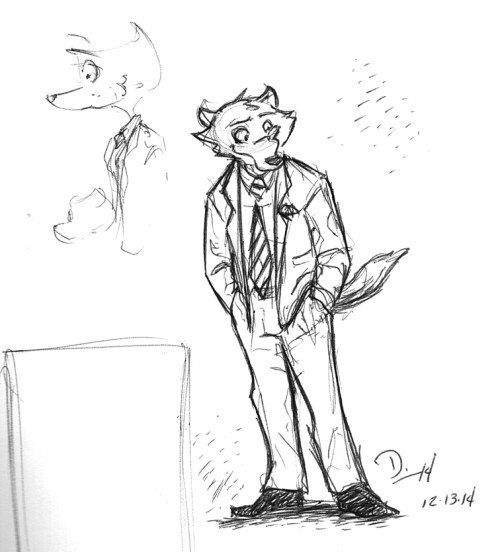
Translating Dad’s wolf into my style. A sloppy version of how my father draws it is at the top left.
I tried to create a basic amalgam of everything his cartoons do into a single image, and have it take place at the Spirit of San Luis. Most of his cartoons are of the wolf trying to charm a cat-waitress and the punchline usually revolves around the waitress rejecting him through the gesture of offering him a cup of coffee. These are accompanied by a light, entendre-based question from the wolf and a very concise and clear declaration from the waitress. Rather than coming up with a joke, knowing it would probably be too forced and/or something he had already used and, thus, fall into pastiche territory, I decided to try it silent, with the sentiment intimated through posture and structure. So, with research and memory I tried to put the pieces together.
I had never really drawn anything as an expression before. My art rests heavily on narrative. But I found that I was going by feel a bit while drawing this; not in the sense that I was eyeballing proportions or things like that, but I course-corrected whenever the pose/background/layout didn’t capture a sense of “dad.” In that sense, this is probably the only piece of “art” I’ve ever made in that I was not only telling a story but I was trying to say something, albeit something incredibly personal to a very specific audience of one.
In the final drawing, I see all of the influences; there’s a little bit of Chuck Jones, a little bit of Dave Stevens (which I never thought would come out in my art), a bit of the European artists that have also popped up in Long John, and of course I see my dad’s work in here. However, just by sitting down and writing this out, thinking about the nearly century’s worth of my family putting pen to paper, I can’t ignore the bedrock of inspiration that supports this drawing and all of my art in general. All three of us came to art independently. I think my dad eventually asked my grandfather for advice or lessons, but we all started with a desire to try and make lines connect. Even though it’s not something I can point to or show, it’s good to know that it’s there, a figurative set of tools each generation seemed to find on their own that I’m happy to use even if they’ve been in more skilled hands. At the very least, I can build something.

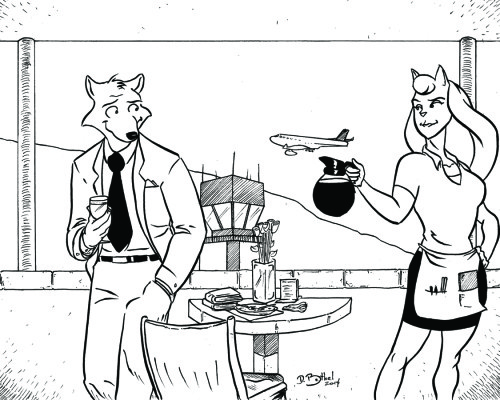
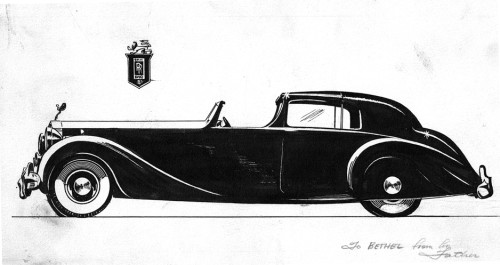
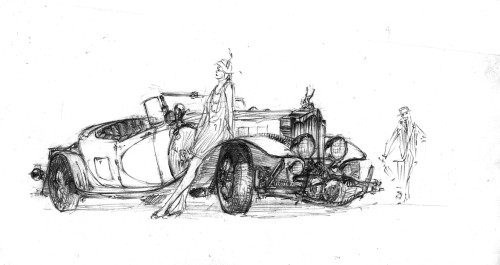
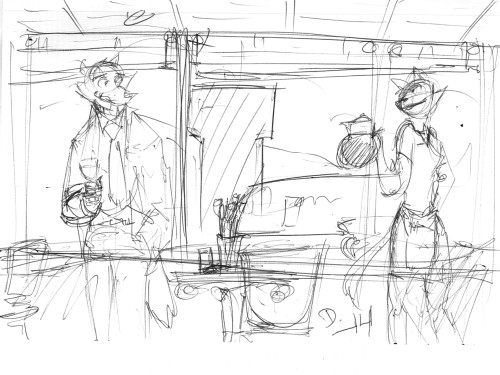
Discussion (2) ¬
Dan: I’m so pleased and touched, and I know my father would be pleased, too. I’m tickled by the way you started with my ideas and made them your own.